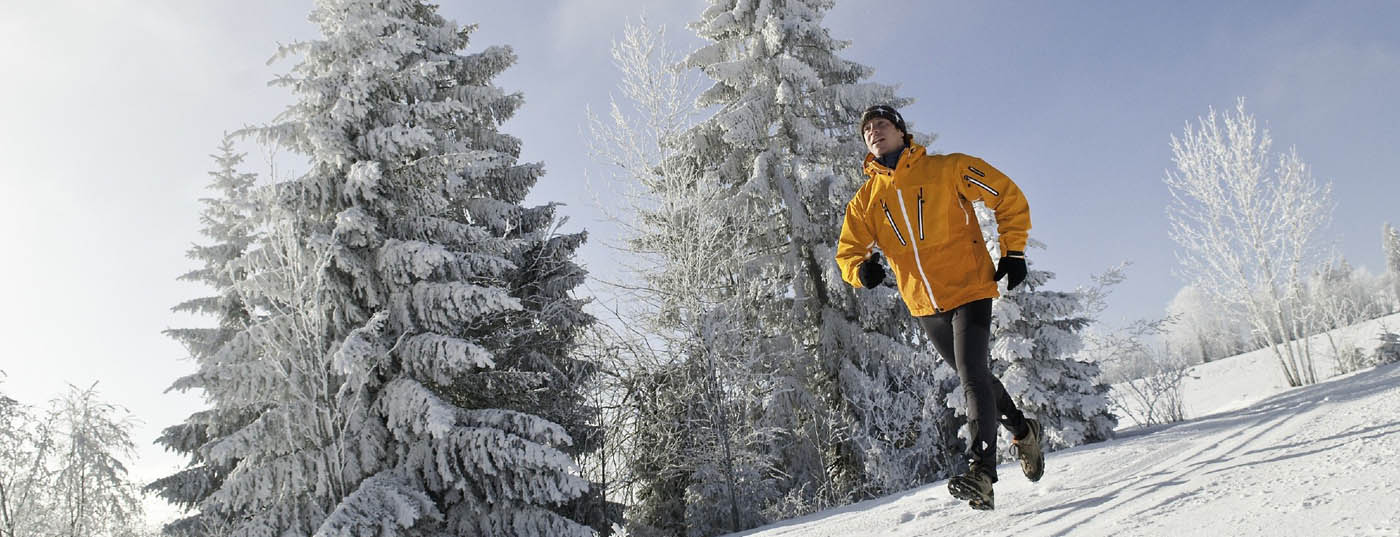A personal experience from past years: At the venue of a World Cup downhill in alpine skiing, the temperature in the finish area is -28° Celsius, at the start – a few hundred meters higher – only -16° Celsius (the cold air does not rise!). However, due to the current (wind) in this race (over 100 km/h), the perceived temperature is about -44° Celsius. How can the body still function somewhat normally at such temperatures? The following article provides information.
The state of knowledge in sports and training science about the influence of cold on the mobilization of athletic performance and on the general thermoregulatory conditions of physical stress situations is still quite limited. But the problem triggers continuous research activities.
As an equally warm being, humans have the property of keeping their core temperature constant at 37° Celsius through certain regulatory mechanisms, even when the ambient temperature changes all around. The body schaIe is the structure, which adapts to the ambient temperature. Thus, in a cold environment, there is a temperature gradient in the trunk from the inside to the outside, and in the extremities there is a decrease in temperature in the longitudinal direction, i.e. from the tips of the limbs to the trunk. Despite this, however, humans have only a low tolerance with regard to changes in body temperature.
During sports the increased temperature is useful
Under normal conditions, the core body temperature measures approximately 37° Celsius. For complete mobilization of individual athletic performance, this normal value should be increased to an optimum temperature of about 39° Celsius. For each degree Celsius rise in temperature, biochemical processes at the cellular level accelerate by about 13%. As an effect of the increase of the body core temperature there is thus the acceleration of the metabolism, the increase of the efficiency of the nervous system and also the contraction speed of the musculature as well as an economization of the oxygen consumption and the oxygen exhaustion of the blood. Conversely, it can be assumed that under the influence of cold, athletic performance is negatively affected. The cooling of the muscle fiber leads to a prolongation of the contraction time, to a prolongation of the relaxation time, to a reduction of the shortening speed of the fibers, to a change in the coordination between the so-called agonist and antagonist muscles (e.g. in the thigh the knee extensors and the knee flexors) and furthermore to a reduction of the maximum muscle force of up to 6% when the body temperature drops from 40° to 30° Celsius. Cooling certain sensitive muscle parts (muscle spindles) to 27° Celsius reduces their responsiveness by half.
Temperature regulation is thus required in the cold: With outside temperatures such as those encountered during the aforementioned descent, a difference of almost 70° Celsius must finally be bridged! It almost goes without saying that this is not always so easy to solve. The extremities, i.e. arms and legs, are particularly challenged in the cold: Skin, tendons and joint capsules are less supplied with blood, they remain stiff and inelastic for longer, which increases the potential risk of injury. But the weather cannot be changed, so it is up to man to adapt to this situation.
Adaptation to cold in humans occurs predominantly through a change in behavior (clothing, staying in warm rooms), much less through a change in the body’s own thermoregulation. Nevertheless, a prolonged stay in a cold environment leads to adaptation phenomena such as a decrease in the subjective sensation of cold, the onset of cold shivering at lower core body temperatures, and an increase in basal metabolic rate (metabolic demand at rest).
Wind and cold – a dangerous mixture
Back to alpine skiing: it must be underlined that, in contrast to cross-country skiing, exposure times are relatively short. A downhill race lasts between 2:15-3:15 minutes for men, and between 1:50-2:30 minutes on average for women. In Super-G, where the speeds are also high, the performance takes even less time (men 2-2:15, women 1:45-2:15). These times are counted from taking off the protective suits at the start to getting dressed again with warming suits in the finish area. There are differences depending on the athlete and rank. Speeds in these two disciplines vary on average for downhill between 100-110 km/h for men, 92-105 for women; in super-G between 90-100 for men, 85-96 for women. These temps have a similar effect to headwinds to some degree, and the effect of wind on perceived temperature is enormous. At -20° “real” outside temperature the body hypothermia is brought to -34° with a wind of 18 km/h, at 36 km/h to -44° and at 54 km/h to -49° Celsius! Scientific measurements at the previously mentioned racing speeds do not exist, but one can see without too much effort what values – even if only for a short time, we repeat – could be reached.
What do the regulations say?
Actually, in the alpine area no restriction (e.g. start ban) is anchored in the regulations. However, the Medical Commission of the International Ski Federation has recommended that competitions not be held at temperatures below -20°. For the responsible physicians, the risks of hypothermia (hypothermia), skin lesions, respiratory problems, cold allergy and damage to the eyes seemed too great at lower temperatures. In any case, it is not surprising that the athletes, who then have to start at lower temperatures, try to protect themselves with the most diverse methods, which by the way work quite well!
Cross-country skiing: Harmful mouth breathing
In cross-country skiing, the temperature can be similarly low, but the big difference is the duration of the stress: here, depending on the race distance, we are talking about hours, not minutes. The effect of cold on the musculoskeletal system of a cross-country skier is identical to that in alpine skiing. A big difference lies in the fact that the aerobic sport of cross-country skiing is very demanding on breathing: The working muscles need large amounts of oxygen, which are offered by greatly increased respiration. That nasal breathing manages to raise an outside air from -40° to almost +37° C when reaching the lungs has been proven, only this nasal breathing is quantitatively not enough. With mouth breathing, which is added to the supplement, this compensation is missing, so that ice-cold air flows through the respiratory tract, with a high potential for damage. And this is probably the biggest problem of practicing cross-country skiing in a (very) cold environment. Here, too, there would be protective measures, but who likes to do sports with a mask?
One thing is certain: skiing is practiced in winter. The likelihood that the temperature can be low is high and so skiers need to address this particular issue. It’s as much about health as it is about performance.
HAUSARZT PRAXIS 2015; 10(1): 3-4











